Poplar Trees: Types, Bark, Leaves – Identification (With Pictures)
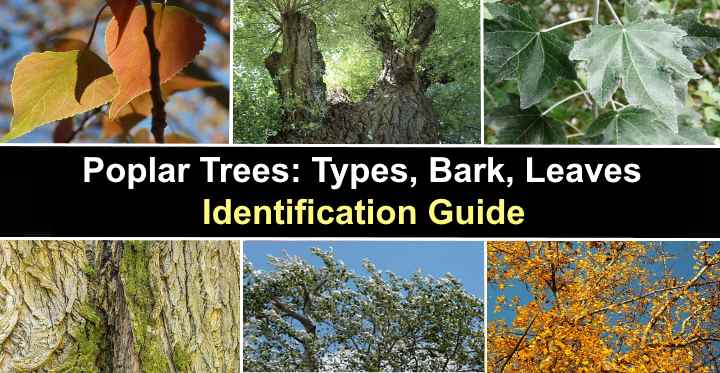
Poplar (Populus) trees are large deciduous trees with rounded to triangular leaves, attractive grayish bark, and small clusters of drooping flowers. Many poplar trees are identified by their bark’s color—white, gray, or black—and triangular, ovate leaves. The white poplar is the most common poplar tree and has white bark and white and green leaves that seem to ‘twinkle’ in gentle breezes. Some species of poplars also have a fresh balsam scent.
Apart from the common white poplar tree (Populus alba), other types of poplars include the black poplar (Populus nigra) and balsam poplar (Populus balsamifera). All poplar species are fast-growing trees that you will find growing in deciduous forests, as ornamental trees in parks or residential landscapes.
This article is a guide to identifying common poplar trees. Descriptions and pictures of poplar leaves, bark, and flowers will help identify different species of poplar.
Poplar Tree Facts
Poplar trees belong to the genus Populus in the willow family Salicaceae. Poplar trees range in height and grow between 20 and 165 ft. (6 – 50 m) tall and up to 70 ft. (21 m) wide. Poplars grow in USDA zones 3 through 9.
Many poplar species are large ornamental trees with wide canopies, making for excellent shade trees. Some poplars, like the Lombardy poplar (Populus nigra ‘Lombardy’), have a columnar growth habit and are ideal privacy trees. Poplars are also perfect for tall privacy hedges to create a windbreak.
Native poplar trees are easy to grow and have a relatively short lifespan. Generally, poplars reach mature height after 12 years and grow for about 50 years in total. These fast-growing trees are good choices for planting in wet, moist ground where there is plenty of space.
Poplars have a shallow root system that can become invasive. You’ll find that poplar roots can disturb lawns and push up pathways. It’s advisable to plant poplars between 20 and 30 ft. (6 – 10 m) away from your house, driveway, or patio because of the spreading root systems.
Other common trees in the Populus genus are cottonwood trees and aspen trees. All trees in the genus Populus share similar characteristics. Poplars are generally tall, fast-growing, and short-lived ornamental trees.
It’s important to remember that tulip poplars or yellow poplars don’t belong to the poplar genus Populus.
This article examines the identifying features of Populus species with the name ‘poplar’ in its common name.
Poplar Tree Bark
The bark on poplar trees is smooth and often a white or silvery-gray color. An identifying feature of poplar trees is the lenticels on the bark. These dark-colored lenticels look like horizontal scores or rough growth. As poplar trees mature, the bark of many species darkens and becomes rough or fissured.
The common white poplar tree can look like birch trees due to its bark. Poplar tree bark is more of a silver-gray color, and its bark doesn’t peel. However, most species of birch trees have exfoliating pure white bark that peels off in strips.
Poplar Tree Leaves
Poplar tree leaves are simple leaves arranged alternately on smooth twigs and vary in size and shape. Typically, poplar tree leaves are triangular or heart-shaped with a pointed end and slightly rounded base. Some species of poplar trees have serrated or toothed margins, whereas others have lobed leaves that resemble maple tree leaves.
The identifying feature of poplar tree species is their green leaves with silvery-white undersides. In the breeze, the fluttering leaves give the poplar trees a shimmering appearance. Some species of poplar trees like the white poplar (Populus alba) and quaking aspen (Populus tremuloides) look like they are continually trembling or quaking.
Poplar Tree Flowers
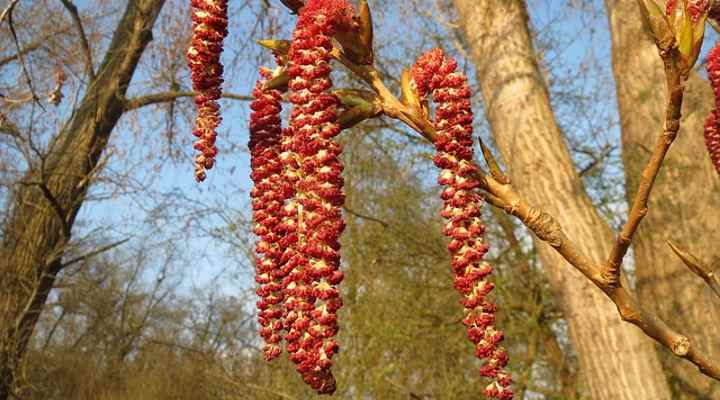
Populus × canadensis (Canadian poplar) flowers
Flowers on poplar trees are long, drooping clusters of tiny flowers called catkins growing in a slender conical form. An identifying feature of most poplar trees is the cotton-like, fuzzy substance that grows after flowers have bloomed. The fine furry, wooly hairs protect the seeds and are easily blown from the tree.
Poplar Tree Identification
To identify species of poplar trees, it’s good to look at the color of bark and leaf shape. You can recognize species of poplars by their leaves. White poplars have oval or lobed leaves with notches on the margins and a silvery underside. Black poplars have rounded leaves, and balsam poplars have triangular leaves with serrated margins.
The most common poplar trees typically have the bark color in their common name.
Types of Poplar Trees (With Pictures)
Let’s look in more detail at common types of poplar trees and how to identify them by their leaf shape and bark color.
White Poplar Tree (Populus alba)
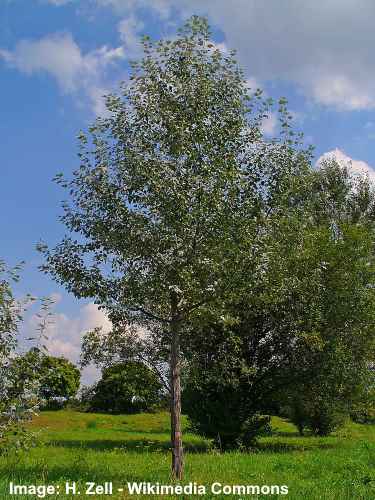
White Poplar Tree (Populus alba)
The white poplar is a large, fast-growing deciduous tree with a broad, rounded crown. White poplar tree leaves have three to five lobes and unevenly serrated margins. You can distinguish white poplar maple-like leaves by their silvery undersides and dark green upper sides. White poplar tree bark is smooth with diamond-shaped marks.
White poplars grow between 50 and 100 ft. (15 – 30 m) tall, and their broad canopy provides plenty of shade. Like most species of poplars, the white poplar thrives in moist to wet, well-drained soil. White poplars grow well in USDA zones 3 through 8 in full sun.
The flowers on white poplar trees are red or grayish-green catkins that grow up to 4” (10 cm) long. The dangling, droopy slender conical flowers on female trees become fluffy like cotton wool and drop in late summer. Due to the white downy poplar seed hairs, white poplars are classed among cottonwood trees.
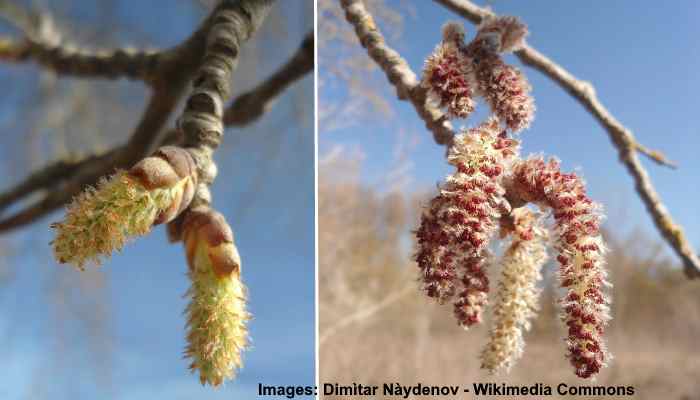
White poplar female flower (left) and male flower (right)
White poplar trees are not ideal for garden landscapes. Their aggressive root system can push up driveways, paths or make lawns look unsightly—not to mention the damage they can do to buildings. The flowers from white poplar trees also become fluffy and cotton-like, making these poplars a messy tree species.
Another consideration before planting white poplars is that the wood is relatively weak. Strong winds can easily snap branches. Due to the poplar tree’s shallow root system, storms can sometimes uproot the tall trees.
To prevent poplar trees from damaging buildings, plant them between 30 and 40 feet (10 – 12 m) away from your house.
White poplar leaves
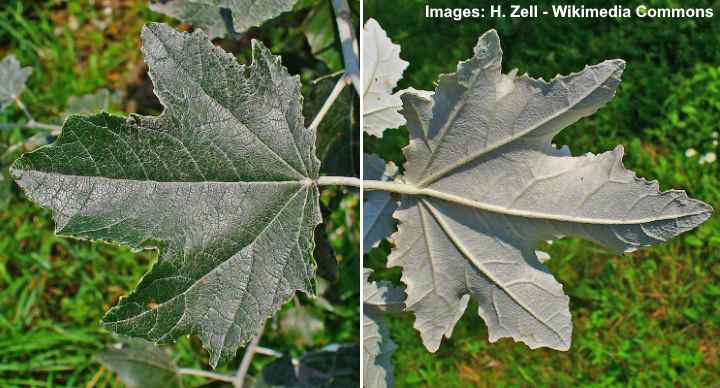
White poplar upper side leaf (left) and underside leaf (right)
White poplar tree leaves are simple, alternately arranged lobed leaves that look like maple leaves. Its leaf blades measure 2” to 4” (5 – 10 cm) long, are dark green on the top and white underneath. A feature of the white poplar leaves is fine hairs coating the silvery underside. White poplar tree doesn’t have any significant fall color.
White poplar bark
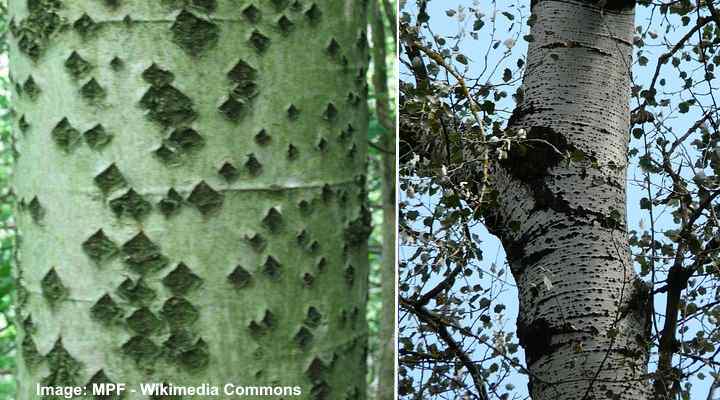
Examples of white poplar bark
White poplar tree bark is thin and smooth with a gray-green appearance. This poplar is identified by thin horizontal lines around the trunk and diamond-shaped marks. As white poplar trees mature, the bark develops pronounced furrows that look black.
Black Poplar Tree (Populus nigra)
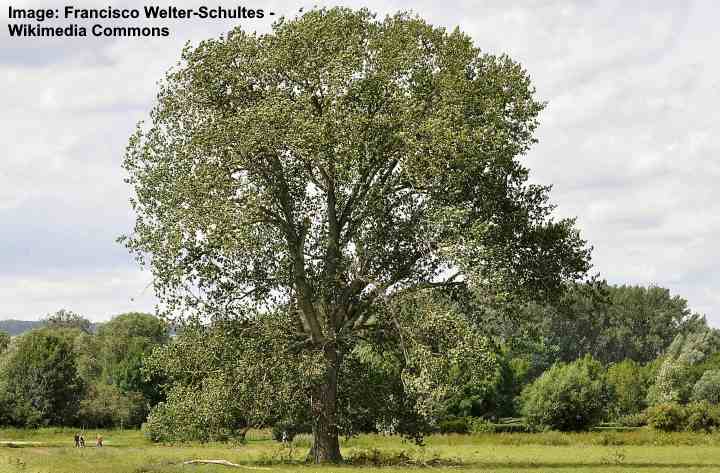
Black Poplar Tree (Populus nigra)
The black poplar tree is a large deciduous, broadleaved tree with triangular shiny green leaves with finely toothed margins and elongated tips. Black poplars grow between 65 and 100 ft. (20 – 30 m). The black poplar tree gets its common name from its dark, rough bark.
Black poplars are also flowering trees. Like the white poplar species, the black poplar male tree produces red flowering catkins, and the female trees have yellowish-green ones.
Black poplar leaves
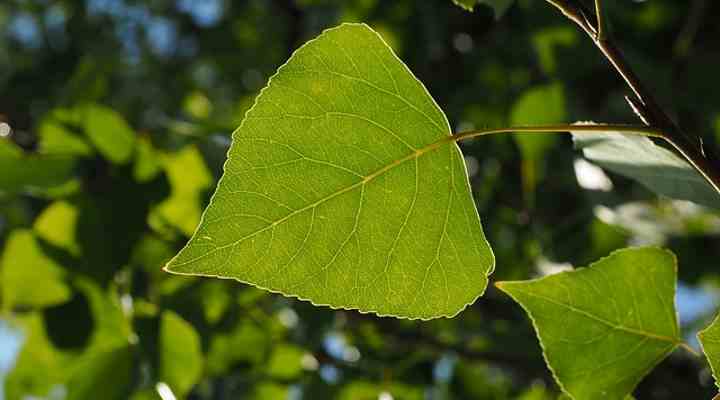
Black poplar leaves
Black poplar tree leaves look like triangles with long tips. Up close, pictures of these poplar tree leaves show a fine serration along the blade margins. Black poplar leaves are between 2” and 3” (5 – 8 cm) long and up to 3” (8 cm) wide. Leaves on black poplar trees turn yellow in the fall.
Black poplar bark
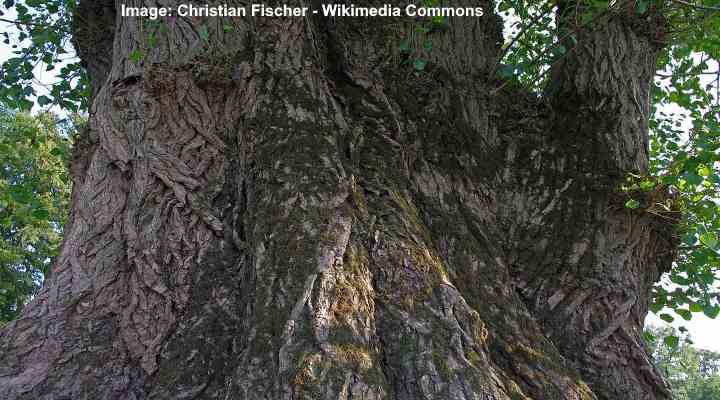
Black poplar bark
Black poplar tree bark is dark gray with a rough appearance and furrowed texture.
Lombardy Poplar (Populus nigra ‘Italica’)
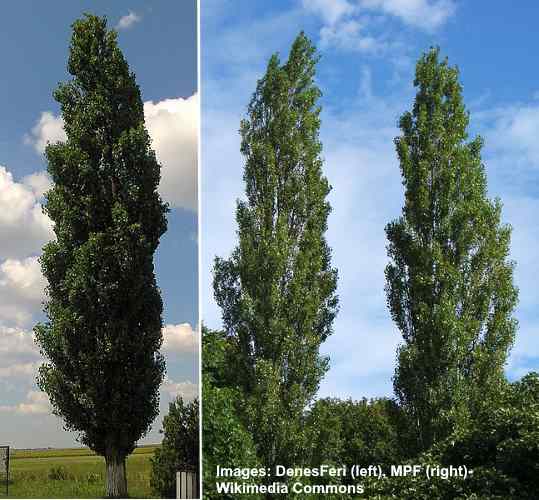
Lombardy Poplar (Populus nigra ‘Italica’)
The Lombardy poplar tree is a stunning tall, slender tree with upright branching growth, triangular leaves, and dark gray, furrowed bark. The outstanding feature of the Lombardy poplar is its narrow, columnar growth. This tall skinny poplar tree grows between 40 and 50 ft. (12 – 15 m) tall and between 10 and 15 ft. (3 – 4.5 m) wide.
The Lombardy poplar is classed as a fastigiate tree—meaning that its branches grow upward, almost parallel to the straight trunk. The best use of Lombardy poplar trees is for growing as a tall privacy hedge or windbreak. The tree’s dense foliage creates a natural screen up to 50 ft. (15 m) tall.
Also called the Italian poplar, the columnar tree is a messy tree due to its fluffy clumps of white seed hairs that blow around in the summer. Also, the poplar’s shallow roots and aggressive nature make it unsuitable as an ornamental landscape tree.
Lombardy poplar leaves
Lombardy poplar tree leaves are deltoid (triangular) shaped with a pointed tip and finely-toothed blade margins. The bright green poplar leaves are 2” to 4” (5 – 10 cm) long. Unlike white poplars, Lombardy poplars have an attractive fall color when the leaves turn golden yellow.
Lombardy poplar bark
Lombardy poplar tree bark has a rough texture and a dark gray-green color that becomes black and fissured as it matures.
Necklace Poplar (Populus deltoides)
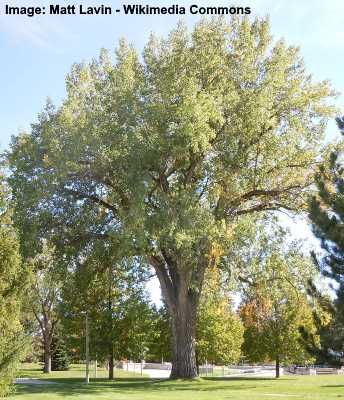
Necklace Poplar (Populus deltoides)
The necklace poplar tree is a colossal poplar tree with silvery-white bark, large triangular leaves, and reddish-purple or green, drooping flowers. Also called the eastern cottonwood tree, the necklace poplar flowers become white and fuzzy as they turn to seed. The necklace poplar grows between 65 and 195 ft. (20 – 60 m) tall.
Unlike many other types of poplars, the necklace poplar lives a long time. You can expect these poplars to live for between 70 and 100 years—much longer than the standard 20 or 30 years for most poplars.
Necklace poplar leaves
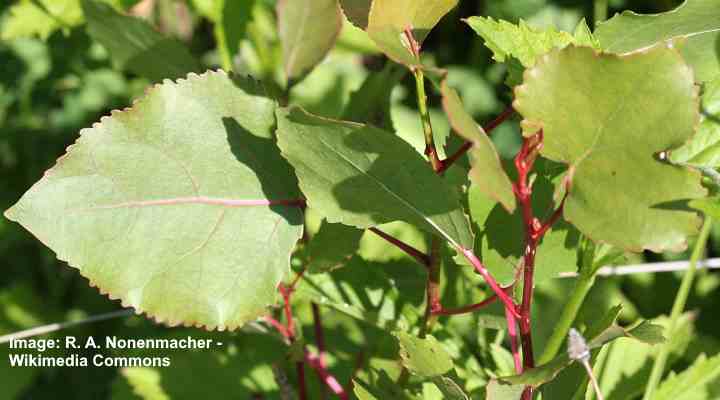
Necklace poplar leaves
Necklace poplar tree leaves have a triangle shape with coarsely toothed margins. The leaves are attached to the branch by flattened petioles that cause them to flutter constantly. The leaves on this poplar species turn from dark green to yellow in the fall.
Necklace poplar bark
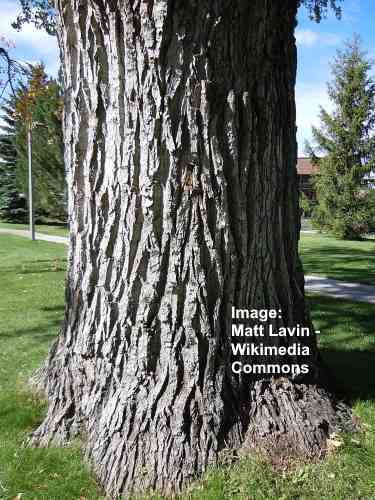
Bark of mature Necklace poplar tree
Necklace poplar tree bark looks smooth and silvery when the tree is young. The bark on mature necklace poplar trees is dark gray with deep fissures giving the tree trunk a rough texture.
Balsam Poplar (Populus balsamifera)
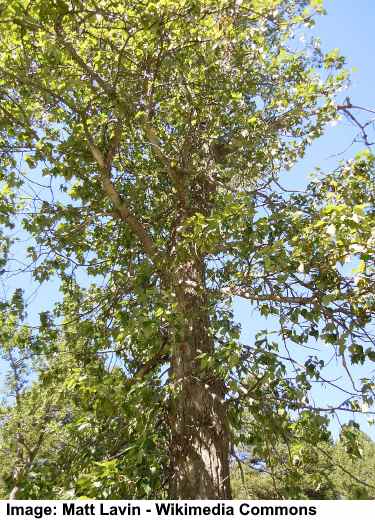
Balsam Poplar (Populus balsamifera)
The balsam poplar tree is a hardwood tree with fast growth, simple lanceolate or ovate, shiny green leaves, and reddish-gray, furrowed bark. The balsam poplar gets its name from the sticky, strong-smelling substance from the tree buds that resembles balsam fir trees. Balsam poplars grow between 80 and 130 ft. (25 – 40 m) tall.
Balsam poplar trees are cold-hardy deciduous trees that grow well in USDA zones 2 through 7. Like all poplars, the balsam poplar thrives in damp, well-draining soil and full sun.
Balsam poplar leaves
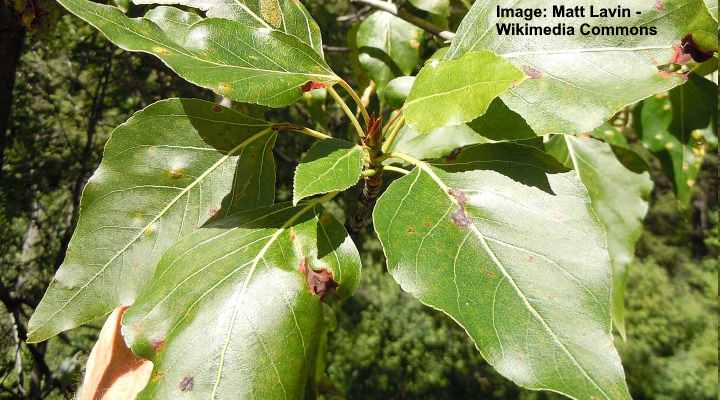
Balsam poplar leaves
Balsam poplar tree leaves are narrow, ovately shaped with a protruding tip and finely-serrated margins. The dark green simple leaves are alternately arranged on branches. Balsam tree leaves have a fresh, aromatic scent of balsam. The leaves grow up to 2.3” (6 cm) long and 2” (5 cm) wide.
Balsam poplar bark
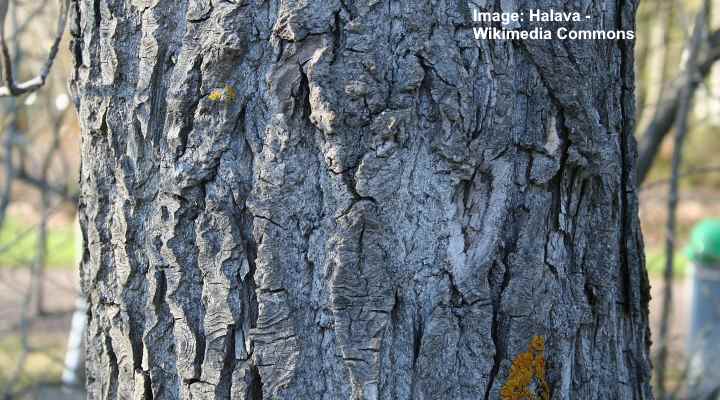
Balsam poplar bark (mature tree)
Balsam poplar tree bark is smooth and gray when the tree is young. As the poplar tree matures, the bark becomes dark and fissured with long, scaly ridges.
Western Balsam Poplar (Populus trichocarpa)
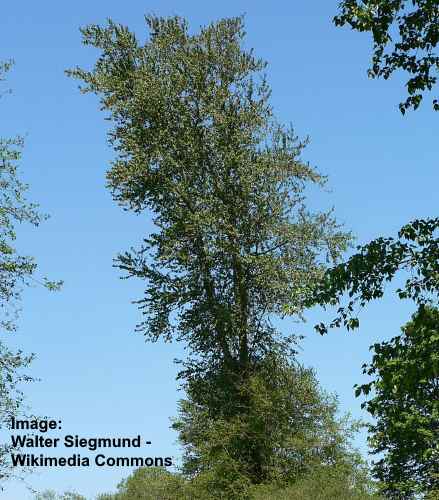
Western Balsam Poplar (Populus trichocarpa)
The western balsam poplar is a large deciduous tree native to North America. Also called the black cottonwood, western balsam poplar is identified by long, shiny dark green leaves, hard gray bark, and red or green dangling flowers or catkins. Western balsam poplars grow between 100 and 165 ft. (30 – 50 m) tall.
The immense size of this poplar makes the western balsam poplar the largest of the native American species.
The western balsam poplar tree has a large, dense conical crown. The lower branches tend to droop down, giving the lower part of the tree a slightly weeping appearance. Due to its aggressive and robust root system, it’s best to plant this poplar species away from buildings.
Western balsam poplar leaves
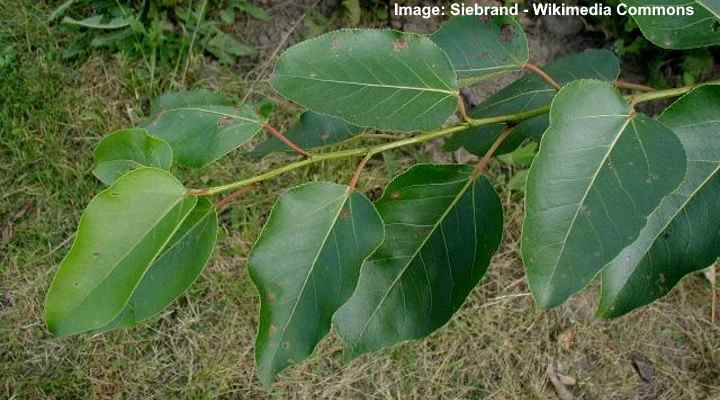
Western balsam poplar leaves
Western balsam poplar tree leaves are identified as simple leaves that are broadly ovate and grow alternately on branches. The leaves grow 3” to 5” (7 – 12 cm) long and have a wedge or heart shape. There is fine serration along the blade margins. The broad leaves have a dark green upper side and silvery-green underside.
Western balsam poplar bark
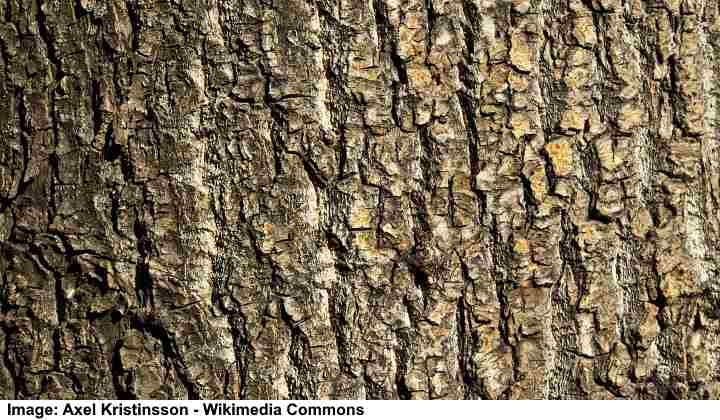
Western balsam poplar bark
Western balsam poplar tree bark becomes dark grayish-brown with pronounced ridges and grooves.
Canadian poplar (Populus × canadensis)
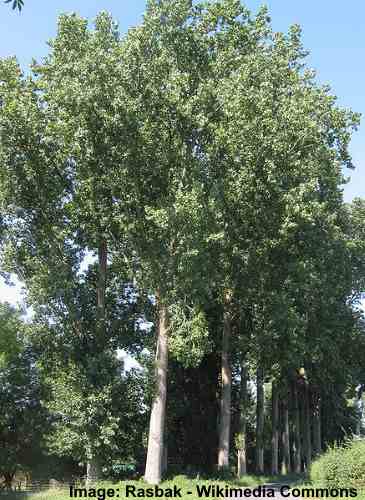
Canadian poplar (Populus × canadensis)
The Canadian poplar is an attractive broadly columnar tree with ovate, heart-shaped glossy green leaves growing densely on the branches. This poplar species grows up to 130 ft. (40 m). The tall tree is recognized by its rounded, narrowly spreading crown. In the spring, male Canadian poplar trees produce red flowers on long drooping catkins.
Also called the Carolina poplar, Canadian poplar is a hybrid poplar tree which is a cross between the black poplar (Populus nigra) and the necklace poplar (Populus deltoides).
Canadian poplar leaves
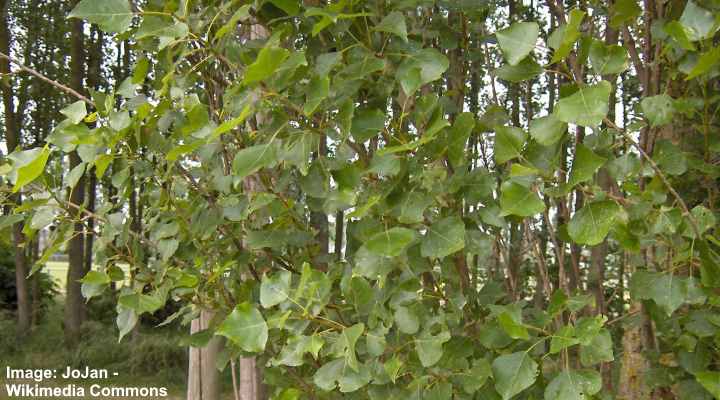
Canadian poplar leaves
Canadian poplar tree leaves are wedge-shaped with a flat or rounded base, serrated margins, and a tapered tip. Like other poplars, the Canadian poplar leaves have long flattened petioles that make the shiny leaves flutter in gentle breezes.
Canadian poplar bark
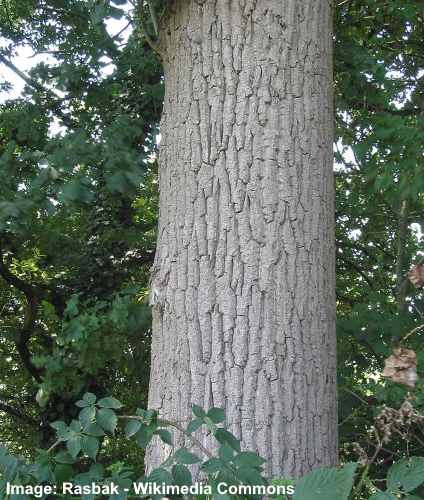
Canadian poplar tree bark
Canadian poplar tree bark is white and smooth and gradually becomes furrowed and black as it reaches maturity.
Gray Poplar Tree (Populus × canescens)
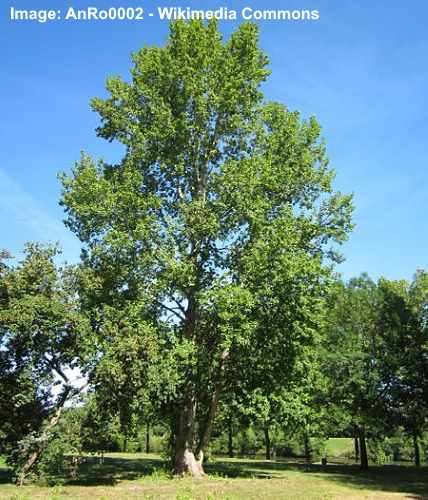
Gray Poplar Tree (Populus × canescens)
The gray poplar is a fast-growing, vigorous tall tree with dark green leaves with a fuzzy silvery underside. Gray poplars have a wide, spreading growth habit forming an uneven rounded crown. This hybrid poplar species grows between 40 and 70 ft. (12 – 21 m).
Gray poplar leaves
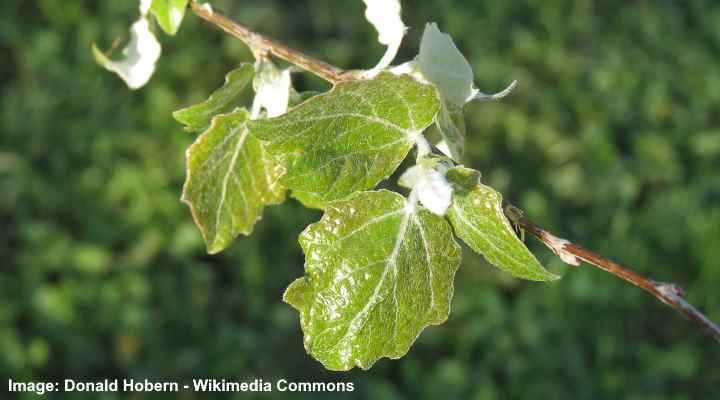
Gray poplar tree leaves
Gray poplar tree leaves are rounded to oval blades with roughly serrated margins. The round simple poplar leaves attach to the branch in an alternate arrangement on short petioles.
Gray poplar bark

Gray poplar bark on a mature tree
Gray poplar bark looks white and smooth when the tree is young. The bark gradually develops a darker gray color with some shallow fissuring on the trunk.
Related articles:
